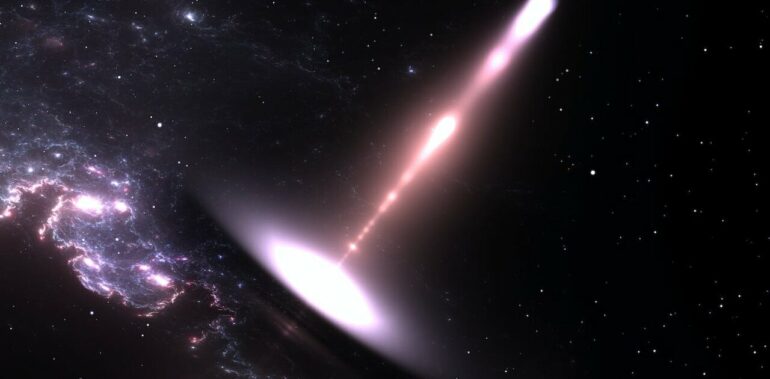Galaxies, including our Milky Way, host supermassive black holes in their centers, and their masses are millions to billions of times larger than the sun. Some supermassive black holes launch fast-moving plasma outflows which emit strong radio signals, known as radio jets.
Radio jets were first discovered in the 1970s. But much remains unknown about how they are produced, especially their energy source and plasma loading mechanism.
Recently, the Event Horizon Telescope Collaboration uncovered radio images of a nearby black hole at the center of the giant elliptical galaxy M87. The observation supported the theory that the spin of the black hole powers radio jets but did little to clarify the plasma loading mechanism.
Now, a research team, led by Tohoku University astrophysicists, has proposed a promising scenario that clarifies plasma loading mechanism into radio jets.
Recent studies have claimed that black holes are highly magnetized because magnetized plasma inside galaxies carries magnetic fields into the black hole. Then, neighboring magnetic energy transiently releases its energy via magnetic reconnection, energizing the plasma surrounding the black hole. This magnetic reconnection provides the energy source for solar flares.
Plasmas in solar flares give off ultraviolet and X-rays; whereas the magnetic reconnection around the black hole can cause gamma-ray emission since the released energy per plasma particle is much higher than that for a solar flare.
The present scenario proposes that the emitted gamma rays interact with each other and produce copious electron-positron pairs, which are loaded into the radio jets.
This explains the large amount of plasma observed in radio jets, consistent with the M87 observations. Additionally, the scenario makes note that radio signal strengths vary from black hole to black hole. For example, radio jets around Sgr A*—the supermassive black hole in our Milky Way—are too faint and undetectable by current radio facilities.
Also, the scenario predicts short-term X-ray emission when plasma is loaded into radio jets. These X-ray signals are missed with current X-ray detectors, but they are observable by planned X-ray detectors.
“Under this scenario, future X-ray astronomy will be able to unravel the plasma loading mechanism into radio jets, a long-standing mystery of black holes,” says Shigeo Kimura, lead author of the study.
Details of Kimura and his team’s research were published in The Astrophysical Journal Letters on September 29, 2022.
More information:
Shigeo S. Kimura et al, Magnetic Reconnection in Black Hole Magnetospheres: Lepton Loading into Jets, Superluminal Radio Blobs, and Multiwavelength Flares, The Astrophysical Journal Letters (2022). DOI: 10.3847/2041-8213/ac8d5a
Citation:
Exploring the plasma loading mechanism of radio jets launched from black holes (2022, September 30)


